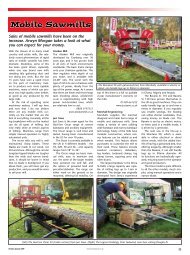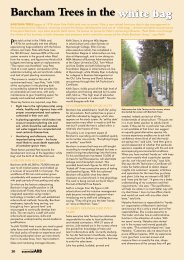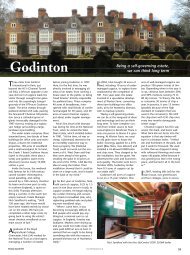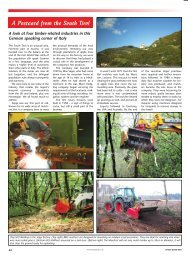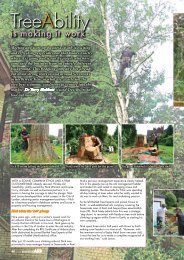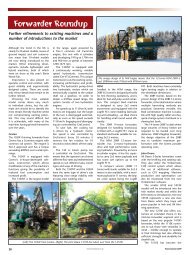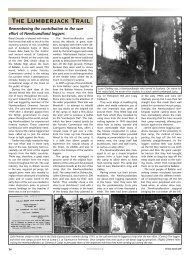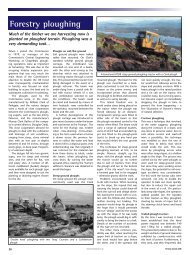HAMPSTEAD HEATH - Forestry Journal
HAMPSTEAD HEATH - Forestry Journal
HAMPSTEAD HEATH - Forestry Journal
Create successful ePaper yourself
Turn your PDF publications into a flip-book with our unique Google optimized e-Paper software.
A beech monolith has been fracturepruned and coronet cut to create safe,ecologically viable, standing deadwood.decompacted alternate quadrants, followedby mulching. The tree is seemingly happyand still functioning. We can tell by its ‘biomechanic’body language – the flare at theroot plate – that there are decay issues inthe basal region. We will keep an eye on it.”Along the deer park perimeter, four veteranoaks (including one resting on its ‘elbow’)have been made safe. “Seven years ago,we noticed one root plate starting to lift. Apublic path ran under the tilting canopy,so we moved the risk target, the public,re-laying the path outside the root zone onthe opposite side of the trees. When thetree fell, the danger had been removed.With its roots intact, the tree is still growingand could live for another 200 years. It cost£6,000–£10,000, a sympathetic solutionthat saved the tree.”The pergola (a 1.5 km vine-wrappedVictorian walkway once hidden in thegrounds of Inverforth House) runs alongsideWest Heath, where a 100-year-old 25.7metre Sorbus torminalis (Wild Service) treehas just become a national champion.Below a hemmed-in Victorian-planted Tuliptree, London planes and Acer capidocums,two monoliths stand proud in the woodlandedge. “We manage twenty natural pollardsand have created fifty monoliths, which wemanage and re-manage. The hornbeamdied over time. It has had two reductionsand we will make a third, taking a final fourmetres out of the crown. On the beech, weused fracture pruning and coronet cuts tocreate safe, ecologically viable, standingdeadwood.“David kneels beside a path to photographmycorrhizal mushrooms and admits heis a ‘fung-nut’. He has just assisted theArboricultural Association with the supply ofphotographs for their ‘Fungi on Trees – AnArborist’s Field Guide’ and an online A–Zfungi directory of parasitic, saprophyticAdjacent to Pitts Arch, a listed monument that was the entrance to the garden of William Pitt, Earlof Chatham, when he lived for a year near the Heath. A beech with a naturally grafted side limbholding up one side of the tree is gradually pushing over the flank wall. “English Heritage wantedto maintain the arch by fixing struts to a concrete plinth to be set over the root plate. This is anextraordinary tree, a pollard, perhaps part of an old hedge and I have never seen natural graftinglike it. To the department, this tree has as much heritage as the arch. We excavated trial pits atthe base of the wall to show the architects and engineers the damage caused if the schemewent ahead. Excavating further away from the tree, we identified an area for their concrete plinthbetween the roots. Using an Air-spade to show third parties that a tree needs to be consideredis not a normal part of arboriculture, but it worked and the project was successfully completedthree months ago.”(feeds off deadwood) and mycorrhizalfungus at Arbtalk. “Fungi are a very goodindicator of the state of a tree. Parasiticfungi are the ones to worry about. ‘Chickenof-the-Woods’on an oak means BrownCubicle Rot in the heartwood. Seen in apublic area, most boroughs would fell thetree immediately, because it is a potentiallylitigious issue. Here, we run tests to seewhich individual parts of the tree areaffected and then make a judgment on themanagement.“In 2008, we had a roadside willow (redrisk zone) with ‘Chicken-of-the-Woods’ inthe canopy. We reduced the canopy. Threeyears later, decay at the base provideda completely different managementproblem. No longer worried about limbsfalling off, the whole tree could fall into theroad. Using a Sibtec Digital Microprobe(DMP – an invasive device detecting decayby measuring the resistance of a drillbit against the wood) gave us specificinformation of the tree’s decay for the treereport. In this instance, I determined that thewillow could be maintained as a pollard,eventually hollowing-out. Because we arean in-house team, we have the luxury ofbeing able to re-manage our trees.”Sandy Heath, the most densely wooded andleast-used area on the Heath, sits betweentwo main roads. Passing diseased elmregrowth at roadside and four ‘planted’Scots pine, David says, “Trees taken downat roadside or in the parkland are replacedwith new plantings. In the woodland, asemi-natural environment, we encouragenatural regeneration. Oaks do well herebut they become a problem when thesecondary woodland encroaches on theacid grassland. Heath Hands, a localvolunteer group who started the veterantree survey in 2005, remove oak seedlingsin the parkland for us. One member of thearb team, Casper Price, is nurturing 180indigenous but rare Wild Service seedlings,which do not set seed or germinate in-situ.We will repopulate the Heath when they areready.”Near Two Oak Hill, created by the removalof sand used (in sandbags) to prevent fireand floods spreading during bombing raidsin WW2, a member of the public removesa trowel from his backpack and proceedsto dig up holly whips. David shrugs. Alongwith Japanese knotweed, sycamore androbinia, holly is deemed an invasive species.David and his team are custodians of theHeath and managing the interests of amyriad of different users groups can betricky. “Some people love grassland andwant no trees, others love birds and wantno intervention. Interpretation is the key.Putting up signage before and after worksand explaining, in the local press and inseminars, why we are doing the works.Mountain bikers come into this wood duringthe weekends because it is quiet. They digtracks deep into these paths and causeerosion. This is vandalism and the hardestto manage.”13
Feature: Hampstead HeathAir-spading a London plane tree, root decay investigation.Roots of the London plane tree exposed.Aside from the public, other managementissues include summer limb drop. Flashfloods in the ponds on the east side arecounterbalanced by drought in the west.“Snow brings more visitors onto the Heath,skiing and sledging. Our winter hazardis snow loading. Last year, the number oflimbs snapping out under the weight of thesnow increased. All are logged in our treefailure database back in the office.”The arb team has used their Arbortracksystem since 2006. They have finishedplotting and tagging the veteran treesand 12 kilometres of ‘red risk zone’ trees(perimeter, roads, children’s enclosures,buildings, car parks and major footfall inareas including Parliament Hill, Golders HillPark and the Vale). They will be surveyedevery year. The next task is to survey thegreen zone, including the less frequentlyvisited woodland areas.In the 1890’s, the two oaks were the onlyThe Land Rover and Denka DLK 28-metremewp, used in urban habitat pruning(monolith creation, fracture pruning andcoroneting).(Below) Air-spading: David says, “Weexcavated trial pits at the base of the wallto show the architects and engineers thedamage caused if the scheme went ahead.”trees in Two Oak Hill. Now, encroachedby secondary woodland, David’s team ishelping them to retrench by haloing 1.5metres around both crowns. ”We will comeback in three to five years’ time and hope tosee regeneration beginning lower down.”Leaving the woods, David spots Rigidoporusulmarius (decay fungus) at the base of anold horse chestnut. “It is here every year andsporolating right now. This tree has basaldecay and when the work plan allows, wewill do a small reduction to help mitigatethe load on the canopy.”He concludes, “I have a unique job amongLondon tree officers. Not many get to dona harness these days, and I wonder howconnected some really are to the cycle oftree safety, tree inspection and tree work.I manage the best location by far. Lookat these trees, look at the fungi. I see allthis and get a buzz when I am out here,knowing that I am helping manage all this.”Tree management officer David Humphries. David hasexperienced altercations in the past. “Fifteen years ago,we were working in South Meadow (Highgate) openingit up by felling some oak trees. In those days, there wasno pre-job signage, interpretation or consultation and theperception was that we would clearfell the area. There wasa furore locally, the use of chainsaws was banned. Weused handsaws for deadwooding the trees for six monthsuntil the ban was lifted.”(Below) Bleeding canker indicates that the Heath doessuffer from honey fungus, and the team have noticedthat conkers are getting smaller; chestnut leaf miner isaffecting their ability to self-germinate. They have beeninvolved in an FC Oak Processionary Moth pheromonetrapping programme. So far, they have only found males.Monolith – a White willow, next to a newly created pond.More people visiting the area create a higher ‘target’,and the tree has been made safe as a monolith.14For further information on ColCorp/Hampstead Heath,visit www.cityoflondon.gov.ukFor further information on fungus:www.arbtalk.co.ukFor further information on David:www.treefung-ous.webeden.co.uk



